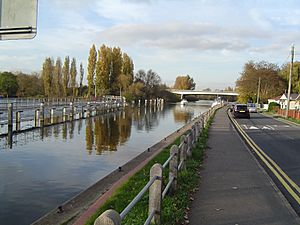Chertsey Lock facts for kids

Chertsey lock with Chertsey Bridge beyond
|
|
| Waterway | River Thames |
|---|---|
| County | Surrey |
| Maintained by | Environment Agency |
| Operation | Hydraulic |
| First built | 1813 |
| Latest built | 1913 |
| Length | 61.16 m (200 ft 8 in) |
| Width | 6.40 m (21 ft 0 in) |
| Fall | 1.22 m (4 ft 0 in) |
| Above sea level | 37 feet (11 m) |
| Distance to Teddington Lock |
13 miles (21 km) |
| Coordinates | 51°23′27″N 0°29′10″W / 51.39083°N 0.48611°W |
| Power is available out of hours | |
Chertsey Lock is a special water gate, called a lock, on the River Thames in England. It is on the left side of the river, in a protected green area that includes Laleham Park. This park is the biggest public park in Spelthorne. The lock is across from the town of Chertsey.
Chertsey Lock is the fifth lowest of the 44 locks along the non-tidal part of the River Thames. Both sides of the river at the lock have been part of Surrey since medieval times. The old stone Chertsey Bridge, built in 1785, is about 210 meters (690 feet) downstream from the lock. The City of London Corporation built the lock in 1813. It was made longer in 1893 and again in 1913 to fit bigger boats. Next to the lock is a small, thin island. This island was made when the lock was built and can be reached by boat. It connects to Chertsey Weir.
Contents
History of Chertsey Lock
Before the lock was built, there were shallow areas upstream called Laleham Gulls. Boats often got stuck there. To fix this, people suggested building up the river banks, and adding a weir and a lock. In 1793, land was surveyed for a lock, but the plan was not approved by parliament.
Another idea came in 1805. It suggested digging a new channel, or "cut," along Laleham with a lock at the end. However, local landowners did not like this plan. In 1810, parliament finally approved a proposal for a lock a little further upstream. But a rich landowner, Lord Lucan, asked for it to be moved. He wanted it out of sight of his home, Laleham Manor House, which he was spending a lot of money to build and redesign.
A new law in 1812 allowed the lock to be built at its current spot, which is downstream. Building started, and the lock opened in 1813. The lock-house, where the lock keeper lives, was also finished on the left bank. The lock was made longer in 1893 and again in 1913. It was first built with two sections, but the middle gates have since been removed. The low-lying left bank of the river here is a small part of the town of Chertsey. This is because the river used to have a very sharp bend there. Since 1974, this area has been managed by Spelthorne Borough Council and Surrey County Council.
Visiting Chertsey Lock
You can reach Chertsey Lock by following the towpath on the left side of the river. This path is next to a road called Thames Side. Downstream from the lock, near Chertsey Bridge, you can find places to eat and drink, like the Kingfisher and the Boathouse. Some of these places also have hotel rooms.
River Area Above the Lock
Right Bank Features
Above the lock, on the right side of the river, you will find Penton Hook Marina. This area has houses and small boatyards. The Abbey River starts here, flowing around Laleham Burway. This is a very large island on the right bank of Chertsey. The Abbey River then rejoins the Thames below Chertsey Lock. The island has some houses in the north, followed by areas of reeds and nettles. Further inland, there is a small water reservoir and water treatment works.
Left Bank Features
On the left bank, near Penton Hook Island, is the clustered village of Laleham. Here, you will see a line of houses with gardens along the riverside. After that, you will find the Burway and Sir William Perkins School Rowing Clubs. A humped road from inland follows the river and Laleham Park all the way to Chertsey Lock. In rowing, the Burway Junior Regatta and Burway Head are annual races held here.
An inlet along the upper left bank feeds a large amount of water into the Queen Mary Reservoir every day. Further downstream, the river is crossed by a bridge carrying the M3 motorway.
Thames Path
The Thames Path is a walking trail that follows the left bank of the river. You can walk along it both above and below Chertsey Lock.


